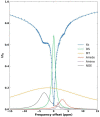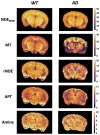Early-stage mapping of macromolecular content in APPNL-F mouse model of Alzheimer's disease using nuclear Overhauser effect MRI
- PMID: 37876875
- PMCID: PMC10590923
- DOI: 10.3389/fnagi.2023.1266859
Early-stage mapping of macromolecular content in APPNL-F mouse model of Alzheimer's disease using nuclear Overhauser effect MRI
Abstract
Non-invasive methods of detecting early-stage Alzheimer's disease (AD) can provide valuable insight into disease pathology, improving the diagnosis and treatment of AD. Nuclear Overhauser enhancement (NOE) MRI is a technique that provides image contrast sensitive to lipid and protein content in the brain. These macromolecules have been shown to be altered in Alzheimer's pathology, with early disruptions in cell membrane integrity and signaling pathways leading to the buildup of amyloid-beta plaques and neurofibrillary tangles. We used template-based analyzes of NOE MRI data and the characteristic Z-spectrum, with parameters optimized for increase specificity to NOE, to detect changes in lipids and proteins in an AD mouse model that recapitulates features of human AD. We find changes in NOE contrast in the hippocampus, hypothalamus, entorhinal cortex, and fimbria, with these changes likely attributed to disruptions in the phospholipid bilayer of cell membranes in both gray and white matter regions. This study suggests that NOE MRI may be a useful tool for monitoring early-stage changes in lipid-mediated metabolism in AD and other disorders with high spatial resolution.
Keywords: Alzheimer’s disease; CEST; NOE; lipid dyshomeostasis; multipool fitting.
Copyright © 2023 Swain, Soni, Wilson, Juul, Benyard, Haris, Kumar, Nanga, Detre, Lee and Reddy.
Conflict of interest statement
The authors declare that the research was conducted in the absence of any commercial or financial relationships that could be construed as a potential conflict of interest.
Figures







Similar articles
-
In Vivo Detection of Gray Matter Neuropathology in the 3xTg Mouse Model of Alzheimer's Disease with Diffusion Tensor Imaging.J Alzheimers Dis. 2017;58(3):841-853. doi: 10.3233/JAD-170136. J Alzheimers Dis. 2017. PMID: 28505976 Free PMC article.
-
Nuclear Overhauser enhancement (NOE) imaging in the human brain at 7T.Neuroimage. 2013 Aug 15;77:114-24. doi: 10.1016/j.neuroimage.2013.03.047. Epub 2013 Apr 6. Neuroimage. 2013. PMID: 23567889 Free PMC article.
-
Age-Dependent Sex Differences in Perineuronal Nets in an APP Mouse Model of Alzheimer's Disease Are Brain Region-Specific.Int J Mol Sci. 2023 Oct 5;24(19):14917. doi: 10.3390/ijms241914917. Int J Mol Sci. 2023. PMID: 37834366 Free PMC article.
-
Examining the potential clinical value of curcumin in the prevention and diagnosis of Alzheimer's disease.Br J Nutr. 2016 Feb 14;115(3):449-65. doi: 10.1017/S0007114515004687. Epub 2015 Dec 14. Br J Nutr. 2016. PMID: 26652155 Review.
-
Alzheimer's disease.Subcell Biochem. 2012;65:329-52. doi: 10.1007/978-94-007-5416-4_14. Subcell Biochem. 2012. PMID: 23225010 Review.
Cited by
-
Diffuse nuclear Overhauser effect MRI contrast changes detected in multiple sclerosis subjects at 7T.Brain Commun. 2025 Feb 20;7(1):fcaf043. doi: 10.1093/braincomms/fcaf043. eCollection 2025. Brain Commun. 2025. PMID: 39980739 Free PMC article.
-
In Vivo Brain B1 + Inhomogeneity Correction and NOE Image Enhancement at 7 T via Flexible Metasurfaces.NMR Biomed. 2025 May;38(5):e70027. doi: 10.1002/nbm.70027. NMR Biomed. 2025. PMID: 40175126 Free PMC article.
-
Chemical exchange saturation transfer MRI for neurodegenerative diseases: An update on clinical and preclinical studies.Neural Regen Res. 2026 Feb 1;21(2):553-568. doi: 10.4103/NRR.NRR-D-24-01246. Epub 2025 Jan 29. Neural Regen Res. 2026. PMID: 39885672 Free PMC article.
-
Detection of sex-specific glutamate changes in subregions of hippocampus in an early-stage Alzheimer's disease mouse model using GluCEST MRI.Alzheimers Dement. 2024 Oct;20(10):7124-7137. doi: 10.1002/alz.14190. Epub 2024 Sep 11. Alzheimers Dement. 2024. PMID: 39262197 Free PMC article.
References
-
- Bao Y. W., Chau A. C. M., Chiu P. K., Shea Y. F., Kwan J. S. K., Chan F. H. W., et al. . (2021). Heterogeneity of amyloid binding in cognitively impaired patients consecutively recruited from a memory clinic: evaluating the utility of quantitative 18F-Flutemetamol PET-CT in discrimination of mild cognitive impairment from Alzheimer's disease and other dementias. J. Alzheimers Dis. 79, 819–832. doi: 10.3233/JAD-200890, PMID: - DOI - PMC - PubMed
Grants and funding
LinkOut - more resources
Full Text Sources
Molecular Biology Databases

